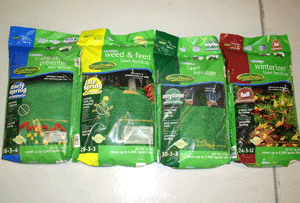Echter's Home
Fertilizers - What the numbers mean
Many people express frustration when it comes to selecting fertilizers. They are often confused by the analysis (expressed by three numbers such as 25-3-6) and the use for all the different fertilizers they see.
 Fertilizers are mixtures
of various major and minor nutrients that are necessary for plant growth.
The major nutrients are nitrogen, phosphorus and potassium and are often
referred to by their chemical signs of N, P and K respectively. These three
nutrients are expressed as percentage by weight in the analysis of the
fertilizer. For example an analysis reading of 25-3-6 means that a minimum
of 25% of the product is nitrogen, at least 3% is phosphorus and at least
6% is potassium.
Fertilizers are mixtures
of various major and minor nutrients that are necessary for plant growth.
The major nutrients are nitrogen, phosphorus and potassium and are often
referred to by their chemical signs of N, P and K respectively. These three
nutrients are expressed as percentage by weight in the analysis of the
fertilizer. For example an analysis reading of 25-3-6 means that a minimum
of 25% of the product is nitrogen, at least 3% is phosphorus and at least
6% is potassium.
Minor nutrients are not always listed on the labels, but when they are, they are also expressed as percentage by weight. Minor nutrients are also necessary for plant growth but in much smaller amounts than nutrients. Minor nutrients include iron, boron, copper, manganese, molybdenum, sulfur, calcium and others.
Many Colorado soils are low in available iron and have a high pH, so itís a good idea to buy fertilizers that have both iron and sulfur listed as minor nutrients. Sulfur, besides being a plant nutrient, helps lower the pH which makes iron more available to the plant for growth. For this reason we recommend fertilizers that have several percent of each of these nutrients. Major nutrients of N, P, K as listed before, are obviously needed in larger amounts than the minor nutrients. Of these, nitrogen is needed in larger amounts than the other two. Nitrogen is THE major nutrient used in plant growth. It is mainly responsible for the deep green color of healthy plant leaves and also is used rapidly during the growth of the plant. Besides being a heavily used nutrient, it also tends to leach out of the soil quickly. For this reason it usually is supplied in the largest quantity in most fertilizers for lawns, trees and shrubs and other plants where green leaf growth is the major consideration.
 Many higher quality
fertilizers now use slow release nitrogen in their formulas. These are
listed as polyon, water insoluble nitrogen (WIN), super urea, sulfur coated
urea and others. These fertilizers really help the homeowner and the environment
by slowing the release of a very leachable nutrient. This allows more even
feeding for the plant and less run off during rains.
Many higher quality
fertilizers now use slow release nitrogen in their formulas. These are
listed as polyon, water insoluble nitrogen (WIN), super urea, sulfur coated
urea and others. These fertilizers really help the homeowner and the environment
by slowing the release of a very leachable nutrient. This allows more even
feeding for the plant and less run off during rains.
Phosphorus functions in plants in the high-energy compounds created during the decomposition of sugars and starches. It is instrumental in producing strong growth and root systems, producing high yields of flowers and fruit and also the maturation of growth and fruits. Phosphorus is immobile in the soil and doesnít leach away. Therefore it is usually not supplied in as large a quantity as nitrogen.
Potassium functions in many enzymatic reactions in the plant but does not become a part of the compounds. It is needed in much smaller amounts than nitrogen and rarely exceeds 10% of the total fertilizer make up.
Most Colorado soils have fairly sufficient amounts of phosphorus and potassium, therefore most lawn and tree fertilizers use these sparingly. For these plants look for a fertilizer with a 3-1-1 to 5-1-1 ratio such as 15-3-3 or 25-5-5. If you are fertilizing flowering plants in the garden a ratio of 1-1-1 to 1-2-1 such as 10-10-10 or 5-10-5 might be better.
Remember that the experts at Echterís can answer most of your questions about which fertilizer is best in your situation.